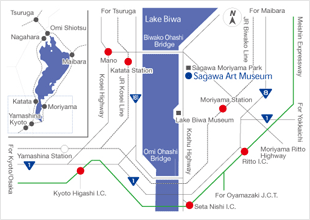 Sagawa Art Museum Raku Kichizaemon Kan - Raku Kichizaemon Pavilion
Sagawa Art Museum Raku Kichizaemon Kan - Raku Kichizaemon PavilionIt is an architecturally unique museum with the underground galleries constructed under the water garden on ground level where the tea room structure is built to resemble a floating isle.
The whole design was produced by Raku Kichizaemon XV based on the concept of “shu-ha-ri, literally “obeying-breaking-leaving”, one of the most famous teachings expressed by Sen Rikyû on rules and manners - obey them to the limit (shu), break them (ha), even leave them (ri), but never forget their fundamentals (hon). The collection consists of works produced by the current generation since the year 2000 including black Raku tea bowls, yakinuki type black tea bowls, tea caddies, fresh water jars, etc. Works by Raku Kichizaemon XV are continually updated.
<Notice of long -term closure>
The Sagawa Art Museum will be closed due to renovations and maintenance during the following period:
September 29, 2025 - end of June, 2026
Reopening date: TBA

 RAKU WARE | Sagawa Art Museum Raku Kichizaemon Kan - Raku Kichizaemon Pavilion
RAKU WARE | Sagawa Art Museum Raku Kichizaemon Kan - Raku Kichizaemon Pavilion